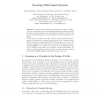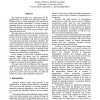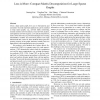1656 search results - page 281 / 332 » Social Hierarchical Learning |
AOSE
2005
Springer
14 years 2 months ago
2005
Springer
Abstract Complex systems call for a hierarchical description. Analogously, the engineering of non-trivial MASs (multiagent systems) requires principles and mechanisms for a multi-l...
WINE
2005
Springer
14 years 2 months ago
2005
Springer
This paper takes the first steps towards designing incentive compatible mechanisms for hierarchical decision making problems involving selfish agents. We call these Stackelberg p...
HICSS
2003
IEEE
14 years 2 months ago
2003
IEEE
The industrial districts are characterized by the agglomeration of medium and small-sized industries, localized within a certain geographic area with precise social and cultural c...
SDM
2007
SIAM
13 years 10 months ago
2007
SIAM
Given a large sparse graph, how can we find patterns and anomalies? Several important applications can be modeled as large sparse graphs, e.g., network traffic monitoring, resea...
AAAI
2006
13 years 10 months ago
2006
Voting (or rank aggregation) is a general method for aggregating the preferences of multiple agents. One important voting rule is the Slater rule. It selects a ranking of the alte...



